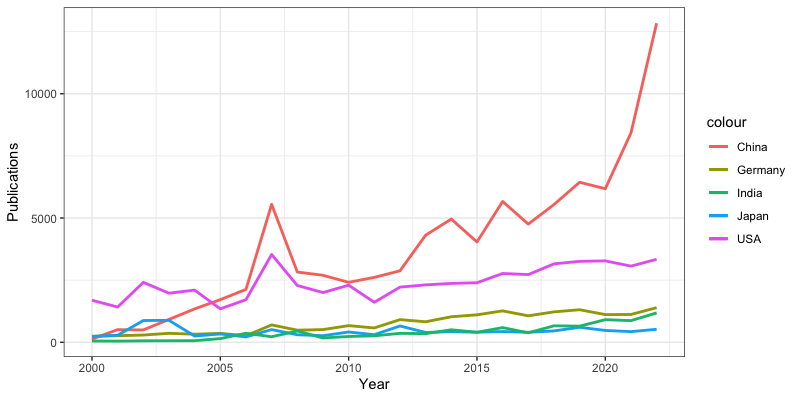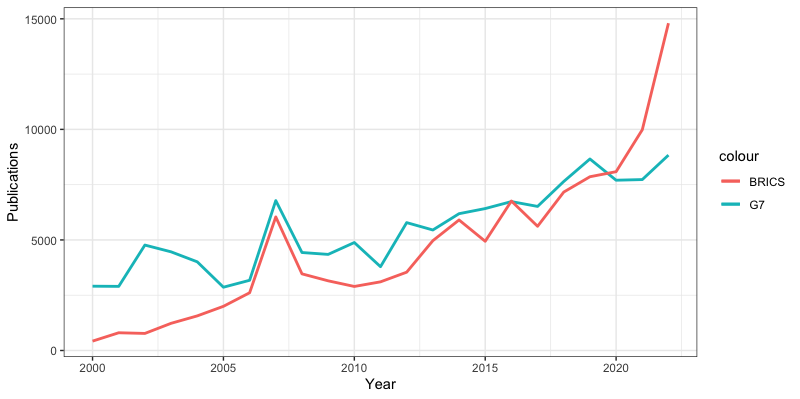Remote Sensing is a research field of particular interest to China. It is, therefore, not surprising that China is doing especially well regarding research output in this field. Here, we are looking at publications in the Web of Science database as a measurement of research output, which is certainly incomplete. However, the validity of looking at the number of publications or citations as a measurement of research output is not the topic here, although that is also an interesting discussion. But, in the following, we are looking at the research output purely quantitatively.

Number of publications in the field of remote sensing included in the Web of Science database
Looking at the number of publications in the field of remote sensing, the strong growth of publications from China becomes very obvious. In the year 2000, few publications were coming out of China, and most literature on remote sensing was published by authors from the USA. In 2005, China overtook the US in the number of publications and continued to grow.
From 2010 onwards, a distinguishable faster growth of publications from China can be seen. Interestingly, this growth rate increases again, even more drastically, after 2020. While we see in many countries a bump in publications in 2020 and 2021, probably caused by the effects of the COVID pandemic on science and output, in China, there is a clear increase in the growth of scientific output in the field of remote sensing.
In recent years, India has also shown a strong growth trend in research output in remote sensing. This seems to be more clear from 2017 onwards. On the other hand, Japan seems to stagnate in the number of publications.
Looking at the country level is very interesting, but due to the number of countries that would need consideration, it can also be a bit confusing. For clearer visualization, we can group countries together. For the sake of this analysis, we look at publications from the G7 countries and compare them with the BRICS countries. The G7 represents the developed and technologically leading countries in the world, while BRICS represents a group of countries that are in this intermediary stage between developing and developed countries. In general, BRICS is a much more diverse group of countries that we selected here mainly to represent these advancing countries, but that still allows us to combine them relatively easily, as they only consist of five members. In this analysis, we use the currently outdated structure of memberships containing Brazil, Russia, India, China, and South Africa, not the new members.

This graph shows a development very similar to the first one, as clearly the overall number of publications in the BRICS countries is dominated by China so a similar trend is visible. Nevertheless, there are differences.
First, looking at the group of countries, the number of publications gets similar around 2005, but then, especially after 2011, grows comparably similar between BRICS and the G7. The BRICS overtake the number of publications in 2020, and afterward, the growth rate is also remarkably stronger. This peak is driven by the Chinese publications, but we also saw that, for example, India shows a strong increase starting around 2018.
There is a shift in the field of remote sensing toward becoming a field dominated by research from China. In the absolute number of publications, this trend is seen for many years. However, this trend is quickly increasing with even faster growth after 2020. This recent explosion in China’s research output will further strengthen China’s dominance in the field. China already publishes more than 50% of all papers in remote sensing per year.
We don’t have the data to prove this assumption, but the growth of publications between 2005-2020 or so seems in China to be driven by the elite institutions. Mostly the 985 and, to some degree, the 211 universities published these papers. This current increase may arise from the further improvements seen in lesser-known universities in China, which include the vast majority of institutions and students that are increasingly starting to publish in well-known journals. If this is the driving factor – again, we don’t have the data yet to support this – then this is just the beginning of an even bigger wave of papers from China to hit the remote sensing world.